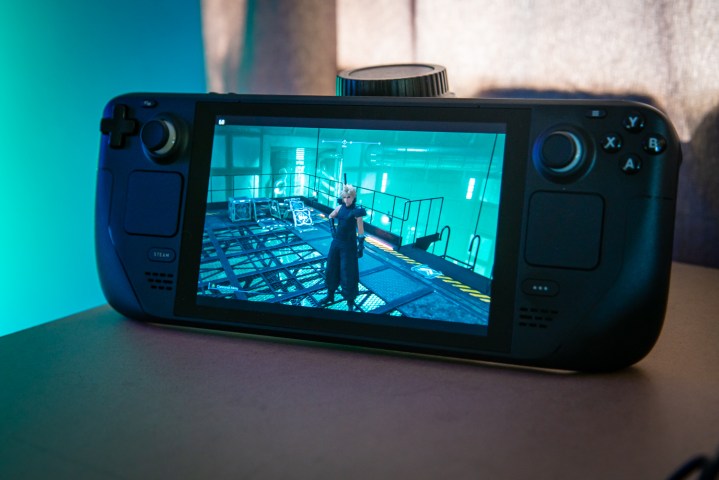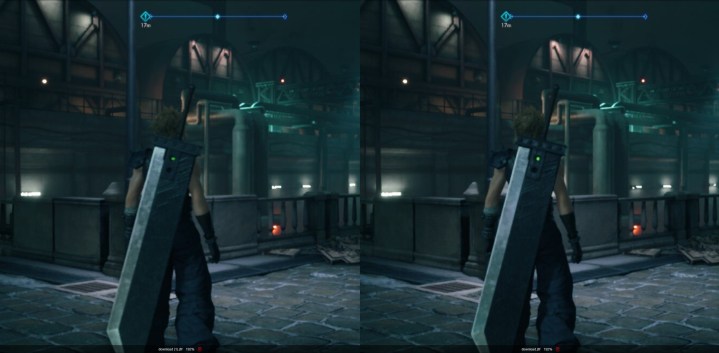Square Enix surprise-launched Final Fantasy VII Remake on Steam during its 25th anniversary livestream, and it leaned heavily on the fact that the game is Steam Deck Verified. For good reason, too. Final Fantasy VII Remake is over two years old, and it’s only been available on PC through the Epic Games Store for six months.
I bit the bullet and bought the game for a third time to answer one question: Is it worth spending $70 again just to play Final Fantasy VII Remake on the Steam Deck? It’s a solid version of the game, much better than I expected it to be, but it still has one major flaw that I hope Square Enix addresses in a future update.
Playing on Steam Deck

Final Fantasy VII Remake is all about fluid combat, so I was immediately worried about the Steam Deck version when I saw it defaulted to a 30 frames-per-second (fps) cap. Thankfully, it seems Square Enix was being conservative. I was able to get through the first mission and the Scorpion Sentinel boss fight while mostly staying at 60 fps.
I didn’t get there without tweaks, though, and unfortunately, Final Fantasy VII Remake doesn’t give you very much room to compromise. You have two graphics settings — shadow quality and texture quality — and they each only have two options. I had to bump both down to Low to get the smooth 60 fps. At High, which is the default, the game hovered in the 40 fps range.

As you can see in the comparison above, these graphics options do very little to impact the look of the game. They can improve performance quite a bit, but I was happy to turn both down to hit a higher frame rate. I wasn’t perfectly locked at 60 fps — a point I’ll address later — but the frame rate drops haven’t hurt the experience so far.
A great look … for a handheld

Final Fantasy VII Remake plays great on the Steam Deck, but it’s still clear you’re getting much less fidelity than you’d get on the PS4 (let alone the PS5). It looks great in motion, where you’ll spend most of your time, but it’s clear that there are some cutbacks in quality if you stare at character models for too long.
Everything looks a bit too basic. Take Cloud’s face above as an example. There’s an impression of more detail, but that detail isn’t there. That’s even more clear on Jessie’s face in the background, which settles into a blurry uncanny valley. The backgrounds look like they have more detail, in fact, which was probably a smart compromise. When the character models are moving, even outside of combat, those details are hard to make out on the Steam Deck’s screen.
The good news is that those lower-resolution assets don’t show up in the game’s many cutscenes. There’s a lot more detail in cutscenes, so unless you stop and really look for problems, you probably won’t notice them.
One major flaw

The biggest issue with Final Fantasy VII Remake on Steam Deck is the resolution. You might be surprised to find out that it’s not too low — it’s actually too high. While 720p is the minimum resolution you can set, for some reason, Square Enix allows you to set the resolution far above 4K on the Steam Deck.
You have AMD’s FidelityFX Super Resolution (FSR) built into the Steam Deck, so enabling it with a lower resolution like 540p would massively help smooth out the frame rate. It’s fairly consistent, but the game still dropped into the 40-fps range with big slam attacks from Scorpion Sentinel and when transitioning into combat.
Lower resolutions are all the more important considering how few graphics options Final Fantasy VII Remake has. I’ve only played the first couple of hours on the Steam Deck, but I imagine there will be frame rate dips well below 60 fps later in the game. FSR would help a lot there considering you don’t have much bandwidth to improve performance in the graphics settings alone.
Still, I’m really happy with Final Fantasy VII Remake on Steam Deck. I expected it to run terribly, but it doesn’t. This is a smooth experience with smart compromises, and I’m excited to finish my journey through Midgar for a third time on Valve’s handheld gaming PC.




